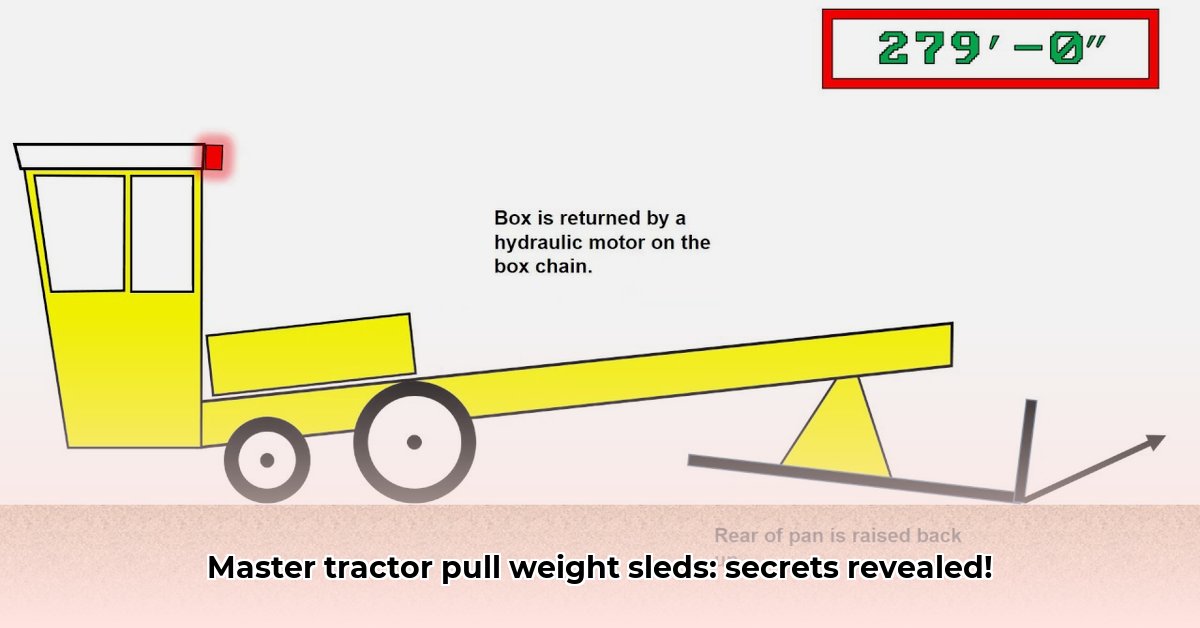
Ever wondered about the massive, heavy objects that tractors strain to pull in those thrilling tractor pulls? That's the weight sled, a critical piece of equipment in both competitive pulling and agricultural settings. This comprehensive guide explores everything from their design and function to maintenance and safety. Whether you're a seasoned competitor or a curious newcomer, this guide will illuminate the mechanics and strategies behind these powerful machines. For more detailed information, check out this weight sled guide.
Understanding the Design and Construction of a Tractor Pull Weight Sled
The heart of a tractor pull weight sled lies in its robust design. Picture a tough steel frame, often constructed from high-strength alloys, forming the foundation. This frame resists bending and fatigue under immense stress during a pull. Weight distribution is paramount—carefully planned to maximize traction and the resistance the sled offers to the tractor. Different designs employ various techniques to achieve optimal weight distribution. Have you ever wondered how engineers achieve this seemingly simple, yet incredibly important balance?
The weight itself is crucial. Concrete blocks, steel weights, or even water-filled tanks are commonly used to reach the desired weight. This isn't arbitrary: weight is meticulously calculated. Heavier sleds naturally pose a greater challenge to tractors, while lighter sleds are used in different competitions or farm applications. The weight is determined by whether it is intended for competitive events with specific regulations or for a farmer's practical use. For example, a farmer might require a sled for testing their tractor for fieldwork, whereas a competitor needs a sled that conforms to competition standards and pushes their tractor to its limit. This variability highlights the sled's critical role in both agricultural settings and the intense world of competitive pulling.
How a Tractor Pull Weight Sled Works: It's All About Resistance
The physics behind a tractor pull are surprisingly straightforward yet incredibly powerful: a tractor pulls a sled across a track. However, the sled's substantial weight and friction with the ground create significant resistance. This resistance is the direct measure of the tractor's pulling power; the farther the tractor pulls the sled, the more powerful it’s deemed. Imagine it as a high-stakes tug-of-war—a battle between the tractor's engine and the immovable mass of the sled, anchored by the ground. This test highlights both raw power and engineering brilliance, encompassing not just moving the sled, but moving it the maximum possible distance.
Exploring the Variety: Different Types and Variations of Tractor Pull Weight Sleds
Tractor pull weight sleds are far from a one-size-fits-all solution; their designs are varied according to their intended purpose, be it competitive pulling or farm work. Sleds for open-class pulling competitions prioritize maximum power. Modified classes allow for clever design tweaks for performance enhancements. The sheer variety in size and weight dramatically affects the challenge they offer competing tractors.
In agriculture, the design priorities change. Farmers often prioritize maneuverability alongside weight, depending on their needs. A farmer using a sled for land preparation will have different requirements than one using it for tractor testing. Many farmers adapt existing sleds or even create custom ones to suit their tasks and local conditions, leading to a wide array of design variations across farms. How many variations have you encountered in your experience with tractor pull weight sleds?
Maintaining Your Tractor Pull Weight Sled: Tips and Tricks for Longevity
Regular maintenance is essential to keep your tractor pull weight sled in optimal condition. Due to the extreme stresses these machines endure, regular inspections are crucial. Inspect for cracks or structural damage, paying close attention to welds and joints. Always check the weight attachments – loose bolts or damaged connectors can pose serious safety risks. Lubricating moving parts is basic upkeep that enhances overall function. Following a set maintenance schedule ensures years of reliable performance. Did you know that a proactive maintenance schedule can extend the lifespan of your weight sled by as much as 25%?
Here's a table summarizing a basic maintenance routine:
| Maintenance Task | Frequency | Important Considerations |
|---|---|---|
| Inspect for cracks | Before each use | Focus on welds, joints and all areas showing stress. |
| Check weight connections | Before each use | Ensure all bolts are tight and secure. |
| Lubricate moving parts | Every 5-10 uses | Use a lubricant suitable for operating conditions and the parts. |
Safety First: Working Safely with Tractor Pull Weight Sleds
Safety is paramount when using tractor pull weight sleds. Never operate one without fully understanding inherent risks. Always wear appropriate safety gear, including sturdy boots and gloves. Double-check that all connections and weight components are securely fastened before each use. Never stand directly behind the sled during operation; the unpredictable movement of such a heavy object poses serious injury risks. Remember, these sleds are incredibly heavy; minor mistakes can have severe consequences. Approach each use cautiously and respectfully, acknowledging the immense power involved. Having an extra person present for assistance and observation is a wise precaution.
Conclusion: The Enduring Power and Importance of Tractor Pull Weight Sleds
From high-stakes competitive pulling to daily farm work, tractor pull weight sleds remain essential tools. Understanding their design, operation, and maintenance is vital for all users. Their power and engineering are captivating, and their role in both agriculture and competition is undeniable. Prioritize safety, and appreciate the strength and ingenuity behind these impressive pieces of equipment. They are more than just sleds; they are testaments to engineering prowess and the constant evolution of agricultural technology.